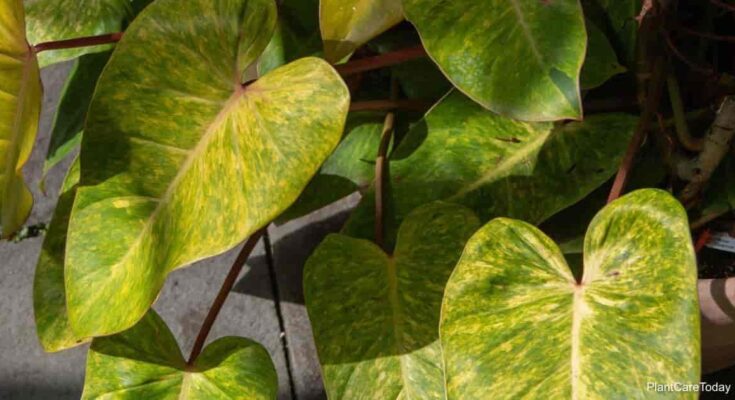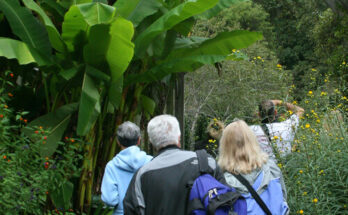Philodendrons (fil-oh-DEN-dron) are perhaps the most famous plants in the Araceae family, with hundreds of species and countless cultivars. One such cultivar is Philodendron ‘Painted Lady’.
Its origins aren’t entirely known, but it’s believed that the plant’s creator, Robert H. McColley, crossed two other cultivars to get ‘Painted Lady’ in the 1960s.
Based on the little evidence we have of its parents, an accepted scientific name for the plant is Philodendron erubescens ‘Burgundy’ x Philodendron erubescens ‘Emerald Queen’.
This somewhat rare perennial is sometimes sold under the nicknames Baursea, Calostigma, and Meconostigma.
Philodendron ‘Painted Lady’ Care
Size and Growth
‘Painted Lady’ is a relatively slow grower and tends to reach a mature indoor height of around 5′ feet when properly supported.
It has a somewhat bushy appearance, with its long leaves causing the plant to reach 12″ to 16″ inches in width.
The plant’s leaves are glossy and heart-shaped.
Young leaves have a neon green color that fades as they mature into a deep green with blotches of yellow that resemble paint splotches.
The veins and petioles share the reddish-pink tinge of its parent species, giving it even more color.
One thing to note is that the leaves often reach around 6″ inches in length indoors but can grow to 1′ foot long when given the proper conditions.
Flowering and Fragrance
As with other philodendrons, it’s extremely rare for ‘Painted lady’ to bloom domestically.
If it does, the green, white, and cream-colored inflorescence is unremarkable and gives off an unpleasant odor.
Light and Temperature
This philodendron requires bright, indirect light if you want the best results.
It can tolerate partial shade, but you’ll lose the variegation.
Likewise, direct exposure to sunlight can result in scorching, as this genus is adapted to live under a dense canopy.
One easy way to ensure the plant gets enough light is to put it beside a south-facing window where the sun’s rays won’t directly hit it.
You can also use a sheer curtain to filter the sunlight.
If you have a window to the east or west that gets around 3 hours of full sun but is shaded from the harsher afternoon light, these are spots where the plant can actually enjoy direct sunlight.
Finally, ‘Painted Lady’ responds well when natural light is augmented with grow lamps.
As a tropical plant, ‘Painted Lady’ loves moderate to high humidity.
The plant will be fine at 40% to 60% percent but may develop smaller leaves.
However, avoid humidity levels above 80% to 85% percent, as this drastically increases the risk of fungal infections.
You can augment the humidity with a pebble tray, plant grouping, or a humidifier.
It also does really well in terrariums. It’s possible to grow this plant outdoors in USDA hardiness zones 9b to 11, but they fare much better indoors.
Unlike most philodendrons, ‘Painted Lady’ is far less tolerant of temperature fluctuations.
Ideally, you should keep it in a temperature range of 68 to 80° degrees Fahrenheit, but it can tolerate down to 55° degrees Fahrenheit.
However, the plant will go dormant at these temperatures, and anything below 50° Fahrenheit can permanently damage the foliage.
You should also keep the plant away from sources of sudden temperature shifts, such as air conditioners, vents, or frequently used doors.
Watering and Feeding
The soak-and-dry method works great for this plant.
Simply stick your finger into the soil and water if the soil is dry 1 to 2” inches down.
Always use distilled or natural rainwater for this plant as it can be sensitive.
Pour slowly and evenly, working your way around the plant and doing your best not to get any water on it.
Stop when you see moisture seeping from the drainage holes or the soil surface is no longer absorbing at the same rate you’re pouring.
A balanced liquid houseplant fertilizer is ideal for this Philo, and you won’t need much.
You can either give it a full dose monthly during spring and summer (following the package instructions) or a dose cut to half every two weeks during this growth period.
Soil and Transplanting
Well-draining soil with a slightly acidic to neutral pH (6.1 to 7.4) will work.
However, an African violet mix with about 30% percent perlite or coarse sand added is perfect.
Alternatively, you can go with a soil fre4e mix by combining the following:
- 4 parts coconut coir
- 2 parts of orchid bark
- 1 part activated charcoal
- 1 part perlite
- 1 part pumice
- 1 part worm castings
This mix is perfectly balanced and will also work for most aroids.
You will generally need to repot this plant only once every 2 to 3 years.
This is the perfect time to replace the potting medium, which not only replenishes the nutrients but will also remove any mineral wastes or chemicals that have been building up in the old soil.
However, if you see roots beginning to poke out of the drainage holes or soil surface, you can transfer the plant to a container one size larger at any point during the growing season.
Grooming and Maintenance
Due to its slow growth rate, you’ll rarely need to prune this plant outside of shaping it or removing damaged or diseased leaves.
Also, as the foliage has a decent mature size, wiping them down once per week or so can help with photosynthesis.
How To Propagate Painted Lady?
It’s unlikely you’ll have access to seeds, but it’s both easier and more fun to propagate through other means.
Try your hand at air layering or use some clippings, which can be propagated in soil or water.
Painted Lady Philodendron Pests Or Diseases
The plant is susceptible to the usual suspects, such as:
- Aphids
- Fungus gnats
- Mealybugs
- Scale
- Spider mites
Likewise, the most common diseases such as black leaf spot, powdery mildew, and root rot are the main risks, usually brought on by high moisture levels or infestations.
As with all Philos, ‘Painted Lady’ contains high amounts of calcium oxalate crystals, which are considered toxic to humans and pets.
Philodendron ‘Painted Lady’ Uses
While this plant will certainly brighten a room in either a hanging basket or as a climber, that’s not the only benefit.
The presence of calcium oxalate allows this plant to draw toxins from the air, helping to purify the entire room.
They also look great as a backdrop for borders or in front of walls when grown outdoors.
Source link
Originally posted 2022-07-20 13:37:28.





